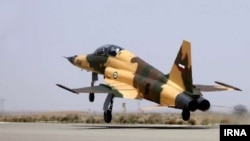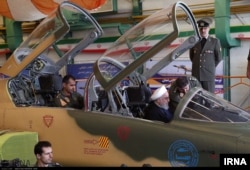Iran’s unveiling this week of a domestically made fighter jet resembling an obsolete U.S. warplane has drawn Western derision about its efficacy as a weapon, but also appreciation of its training potential.
“This is almost a laughable event,” said Michael Pregent, a Middle East analyst at the Washington-based Hudson Institute, in a VOA Persian interview. He was referring to Tuesday’s Iranian state TV report about what it called a fourth-generation Iranian-produced “Kowsar” warplane with “advanced avionics.”
In the broadcast, Iranian President Hassan Rouhani sat in the cockpit as he inspected the fighter jet.
Iranian state TV later showed a takeoff of the warplane and an in-flight video apparently filmed from inside the cockpit. Some Western and Israeli aviation analysts were quick to note the Kowsar’s visual resemblance to the U.S. F-5 Tiger jet that the U.S. military began using in the 1960s. Iran purchased at least 140 F-5 Tigers from the U.S. in the 1970s, before the 1979 revolution that brought to power Tehran’s anti-American Islamist leadership.
“This is an aircraft that we have not used in 20 years, except for training other countries in how to fly American aircraft,” Pregent said. “This dated technology is not intimidating.”
Pregent said the Kowsar’s limitations as a modern-day warplane could hurt Iran more than help.
“Iran wants to be able to project an offensive (aerial) capability in the Strait of Hormuz and to at least demonstrate a similar capability to attack American forces in Iraq and Syria,” he said. “But I think (the Kowsar’s launch) will backfire, because the U.S. will increase its defensive posture in Iraq and Syria and make it very easy to shoot one of them down.”
Any Iranian warplanes crossing into Iraq or Syria could face the U.S. military’s advanced F-16 jets and F-22 stealth jets that have been flying over both nations as part of Operation Inherent Resolve, a U.S.-led coalition operation against the Islamic State militant group.
But the Kowsar may serve one useful purpose for Iran. In a Tuesday report, Iranian state-run news agency Fars said the warplane’s main function is for training missions.
Justin Bronk, an aerial-combat analyst at Britain’s Royal United Services Institute (RUSI), told the Business Insider news site that Iran has faced a shortage of fighter pilots.
“Iran has been relying for a long time on basically a bunch of increasingly old veteran pilots, a lot of whom were trained by — or were trained by those who were trained by — the U.S. before the revolution,” Bronk said.
Using the Kowsar to train a younger generation of Iranian pilots is not a bad idea, in Bronk’s view.
“It makes the most of the limited technology options they have,” he said.
Pentagon Correspondent Carla Babb contributed to this report, which was produced in collaboration with VOA’s Persian Service.









